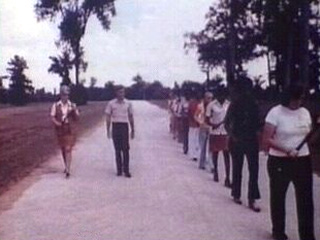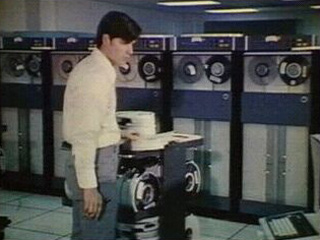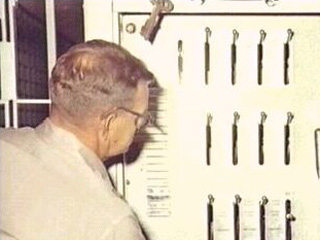Late 1960s - Early 1970s
Women and minorities begin to come into the agency in greater numbers. More females, minorities, and disabled persons serve in positions of responsibility within the organization. The number of inmates continues to rise. As a result, tents became commonplace. The courts intervene, stating that inmates may not be kept in such living conditions. During the 1970s, the inmate population increases 127%.

Corrections experiences an influx of women and minorities.

New staff receive training.
1970
INMATE POPULATION JUNE 30, 1970: 8,793
The first Community Correctional Center for male offenders opens in Jacksonville.

Early data processing.
FIRST DAY OF SCHOOL

David G. Hemme (left) and Daniel R. Bogart (right) during the first class of the Correctional Training Institute entitled "Helping and Human Relations."
Daniel R. Bogart was there when the photo above was taken:
"That photo was taken during the first class of the Correctional Training Institute. The class was Helping and Human Relations, one of the three sections of the 160 hour Correctional Training Institute curriculum. The gentleman sitting on the table with the orange Correctional Training Institute instructor tag is me, Daniel R. Bogart. The gentleman sitting in the chair holding his computerized results from the Myers Briggs Type Indicator is David G. Hemme, who eventually became a superintendent."
"David Hemme was the Director at the time. I was an Instructor in the position of Classroom Teacher II. This was the first few months of the Correctional Training Institute before our titles were reorganized. After the reorganization David became the first Correctional Training Director, and I was the first Assistant Correctional Training Director."
"There were over 900 correctional employees who went through the CTI while I was there. I know that number because I was collecting data for my Ph.D. dissertation during that time. I have to say that Mr. Louie Wainwright was a good Director. Corrections was changing at a tremendous rate and Wainwright knew how to get the most out of the people he had. He was the right person during those transition years."
Two years after his release Clarence Martin is arrested and sentenced to two and a half years for attempted breaking and entering. He begins his 9th and last incarceration at age 70. He is paroled three months prior to his sentence expiring at age 71.
 |
|
Unlike Clarence Martin's previous incarcerations, documentation exists on the circumstances of the last crime for which he is incarcerated in the Florida prison system. According to notes taken by a probation officer who interviewed him, the following occurred on February 15, 1970.
CLARENCE MARTIN'S ARREST
At about 4 in the morning, an Orlando citizen is awakened in his bedroom by a black male who is trying to turn on his bedroom light. The subject runs, the victim gives chase and the subject threatens to shoot. The victim returns home and calls the police. The officer sent to check out the call searches the area, flashing his light down some railroad tracks and spots a black male, who begins to run. Two other officers join the chase. Shortly after, a security guard for the Orlando Utilities Commission spots a black male in the vicinity. He fires his pistol in the air to signal the others that he has spotted the subject, and they discover Clarence Martin lying under a white Ford Falcon belonging to the Orlando Utilities Commission. He is handcuffed, put in the police car and subsequently pleads guilty to a crime he said he didn't commit. He never stands in a lineup for this crime. Martin has $53.37 on him. (The victim says $35 was stolen from his room.) It is noted by the investigator that while "alcohol may be considered pertinent to the offense," Martin is not drunk.
For his part, Martin said he was drinking whiskey all day with a friend, who dropped him off nearby. He said that he was walking down the railroad tracks when a security guard at the Orlando Utilities Commission stopped him and when he began to run the guard fired his gun, so he stopped running. Then he got arrested. But he denied breaking into anything. When asked why he pled guilty if he didn't do anything, he said that if he went to trial, due to his long record he would be sent back to prison.
The investigating officer then states the following: "This supervisor has the distinct impression that this subject is a con artist and a liar. If the subject had nothing to do with the breaking and entering, then he had no reason to run from the police in the first place." He further said, regarding Martin's record that: "It appears that a book could be written about this subject on circumstances revolving around these sentences and their subsequent parole releases. Therefore, this supervisor will let this subject's record speak for itself."
Martin is 70 years old and is facing returning to prison for the ninth time. He has no children, a common law wife and one surviving sister from his original 11 siblings. He does, however, have a boss who speaks highly of him and says he can keep his job if he gets probation instead of prison.
The victim, prosecutor and investigator all feel that, even though Martin is awfully old to be sent to prison, he will undoubtedly continue his life of crime if he is given probation. As the investigator puts it "This subject has been engaged in this type of crime since 1921 and there is little hope that this subject will change at this time. It would be impossible to estimate the number of places this subject has entered or the amount of money he has received in this manner."
Martin returns to prison for his final sentence: 2 1/2 years for attempted breaking and entering, though he continues to maintain that he didn't do this one. He is paroled at age 71 and never returns to the Florida prison system.
Normally the FDC would not know what happened to Clarence after his release, however, out of curiosity, a subsequent social security records check was conducted that determined he died in August 1984 in Orlando, Florida at the age of 83. For the last 12 years of his life, he was not incarcerated in the Florida state prison system.
In 1970 Clarence is one of 4,585 inmates admitted to prison and one of 159 prisoners admitted from Orange County. Of the 8,811 people in Florida prisons on June 30, 1970, slightly more than half (51%) were black. Clarence was one of 954 inmates admitted in 1970 for the offense of breaking and entering. About 20% of all prisoners admitted that year had committed the crime of breaking and entering. Today drug offenses account for most prison admissions.
With the growing change in social climate and dawn of the computer age, "recidivism rates," "career criminals," and "prevention" become common terms found in state legislation and crime research. Today the department offers a vast number of institutional and community based programs to further education, job skills and personal skills as well as post-release transitional housing to assist offenders by providing substance abuse prevention services, transitional housing and other support services.

The seventies saw many more women, minorities, and persons with disabilities take important positions in corrections.

Locking mechanism at Florida State Prison.

Locking mechanism at Florida State Prison.
- 1821-1845
- 1868-1876
- 1877-1895
- 1900-1919
- 1921
- 1922-1924
- 1927
- 1928-1931
- 1932 | CHAPMAN
- 1933-1935
- 1936-1939
- 1940-1945
- 1946-1949
- 1950-1955
- 1956-1961
- 1962 | WAINWRIGHT
- 1963-1965
- 1966-1969
- 1970-1975
- 1976-1979
- 1980-1986
- 1987 | DUGGER
- 1988-1990
- 1991 | SINGLETARY
- 1992-1995
- 1996-1998
- 1999 | MOORE
- 2000-2002
- 2003 | CROSBY
- 2004-2005
- 2006 | MCDONOUGH
- 2007
- 2008 | MCNEIL
- 2009-2010
- 2011 | BUSS
- 2011 | TUCKER
- 2012 | CREWS
- 2013-2014
- 2014 | JONES
- 2015-2018
- 2019 | INCH
- 2020-2021
- 2021 | DIXON
- 2022-Today
- Population Summary Table

